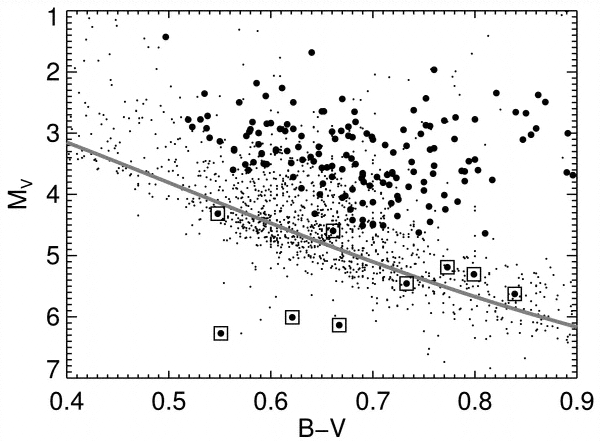The first time I ever gave a colloquium was at Lowell Observatory. I was talking about my graduate work on stellar activity, and Maunder minima.
The “Maunder Minimum” was a period of about 80 years during which there were almost no sunspots. This was just after Galileo’s discovery of sunspots, so in a way it’s lucky he found them when he did, or there wouldn’t have been any to discover for almost another century!
This Minimum presumably also corresponded to a time when the sun was slightly dimmer than usual (sunspots appear when the Sun is very slightly brighter than usual), and indeed this period is connected with the so-called Little Ice Age in Europe, so there’s a climate connection.
In her seminal work on stellar activity, Sally Baliunas measured activity levels, which should track starspot number, for many Sun-like stars to put the Sun in cosmic context. She found that something like like 30% of Sun-like stars were in states analogous to the “Maunder minimum,” with very low activity levels. This discovery had potentially profound implications for global climate models of Earth — if the Sun spent 30% of its time in Maunder minimum states, then perhaps the current climate was unusually warm just because the Sun is brighter (it’s the Sun!).
Well, I had measured activity levels for lots of stars, including much of the Baliunas sample, and found that there were indeed lots of low-activity stars. But I also had a tool that Sally did not: since her work, HIPPARCOS had flown and measured distances to all of these stars. My work had shown that almost all of those low-activity stars were actually overluminous for their colors. They were not, in fact, “Sun-like” at all, but there were older, more massive stars that had run out of hydrogen. They were subgiants. Among truly Sun-like stars, the Sun wasn’t particularly active or inactive.
Why hadn’t anyone noticed this before? Because subgiants look a lot like dwarf stars, except that they’re brighter. The effects of their lesser gravity are actually pretty subtle in their spectra, so if you don’t have parallaxes (distances) it’s very easy to mistake them for dwarfs.
During my colloquium a question came up from the audience while I was showing this figure:

The dark circles in this figure are the “Maunder minimum” analogs that I had found, including those Sally had identified. The gray line is the Main Sequence, where truly Sun-like stars live. The boxed stars are “Sun-like” stars (and subdwarfs) with anomalously low activity, the rest are actually evolved (luminosity goes up, so they are over-luminous, meaning bigger, meaning they are subgiants).
The question from the audience was: “whose sample is that?” I answered that it was a combination of mine, Sally’s, and the sample of Todd Henry. The response came back:
“I’m Todd Henry, and I didn’t have any subgiants in my sample!”
If I had seen Annie Hall at the time, I would have appreciated the “You know nothing of my work” moment.
Well, fortunately for me, Todd was wrong (a rarity!). Those were his stars and, because he didn’t have parallaxes when he constructed his sample, he had inadvertently included lots of subgiants in the sample. Before HIPPARCOS, people just didn’t appreciate how common subgiants are in magnitude limited samples!
A similar issue came up in the context of John Johnson’s thesis work measuring the planet occurrence rate around subgiants: John used HIPPARCOS to find subgiants and look for planets around massive stars, but Jamie Lloyd argued that those stars can’t be as massive as John thinks, because such stars are rare. We’ve gone back and forth over this, and I’m hoping the issue will be settled soon.
ANYWAY, this is all a leadup to a new paper on astro-ph by (future Penn State Hubble Fellow) Fabienne Bastien. I last wrote about Fabienne’s work in the context of “flicker” — the short-period brightness fluctuations in stars that seem to predict both gravity and radial velocity “jitter”.
Well, she has a new paper out using “flicker” to measure gravities (and, thus, luminosities) of lots of Kepler stars. She finds that a stunning 50% of the bright Kepler stars are subgiants. Since subgiants are large, this means that the stars are larger than we thought, which means that a large number of the “small” planets Kepler has discovered are actually 20-30% larger than we thought, especially for stars more massive than 90% of the Sun (so Kepler 186 is OK).
Crazy stuff. Subgiants, subgiants everywhere!

Hi, David, thanks for posting.
Subgiants are overluminous because they are running out of hydrogen, and the higher mean molecular mass in their cores is causing fusion to run more furiously. This always happens at the ends of their lives, after billions of years.
Very young (pre-main sequence) stars can also appear above the Zero-Age Main Sequence, but those stars are always found in star-forming regions and have very high activity levels. All of the stars in that plot are field stars, so settled on the main sequence billions of years ago.
Hi Jason
How do you know the ages of the objects above the MS? Couldn’t they be young? (At least some of them?)
Great posts, I always learn a lot!